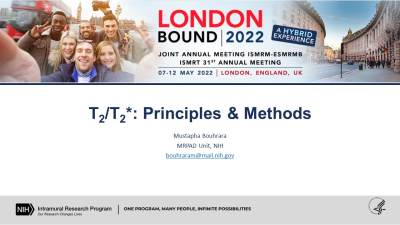Weekend Course
Microstructure: Relaxation, Magnetization Transfer & Susceptibility
Joint Annual Meeting ISMRM-ESMRMB & ISMRT 31st Annual Meeting • 07-12 May 2022 • London, UK

| Magnetization Transfer | |||
| 13:00 | MT: Principles & Methods
David Alsop
Magnetization Transfer (MT) imaging enables the imaging of the molecular constituents of microstructure using conventional water proton imaging methods. The physical basis of MT imaging, methods for acquiring and quantifying MT, and newer developments to enhance MT specificity will be reviewed. Example applications for characterizing tissue microstructure will be presented.
|
||
| 13:25 | MT: Applications
Rebecca Samson
|
||
| Magnetic Susceptibility | |||
| 13:50 | Susceptibility: Principles & Methods
Manisha Aggarwal
This lecture will cover the concepts and principles of magnetic susceptibility as a contrast mechanism in MRI. We will discuss the principles of magnetic susceptibility and its sources in biological tissues. MRI acquisition sequences and methods for generating susceptibility-based contrasts including susceptibility-weighted imaging, quantitative susceptibility mapping, and susceptibility tensor imaging will be discussed. We will explore some recent applications of magnetic susceptibility in MRI for probing various aspects of tissue composition as well as white matter microstructure in the brain.
|
||
| 14:15 | Susceptibility: Applications
Hongjiang Wei
Quantitative susceptibility mapping (QSM) provides a non-invasive way to measure the spatial distribution of magnetic susceptibility. In brain tissue, the susceptibility can originate from several biomaterials and molecules such as iron, myelin, calcium, deoxyhemoglobin, etc. The state and concentration of these molecules may change with brain developmental and aging processes or the pathological processes of neurodegenerative diseases, e.g., Parkinson’s disease, Alzheimer's disease, multiple sclerosis. Furthermore, QSM improves the visualization of deep gray matters, showing the potential to accurately brain segmentation and helpful for atlas construction. Additionally, the applications of QSM outside the brain are also introduced.
|
||
| 14:40 | Break & Meet the Teachers |
||
| T1 Relaxation | |||
| 15:05 | T1: Principles & Methods
Carl Michal
T1 relaxation describes the approach of nuclear spin magnetization to thermal equilibrium and plays a fundamental role in every MRI scan. Relaxation in heterogeneous systems like tissue are complicated by exchange of magnetization amongst different proton pools. This presentation will begin with an introduction to the physical mechanisms of T1 relaxation relevant to MRI in vivo. We will describe several methods for characterizing T1 and consider the impact of magnetization transfer on these measurements. Examples from white matter brain tissue demonstrate that easily misinterpreted effects can be understood as consequences of exchange.
|
||
| 15:30 | T1: Applications
Aviv Mezer
Quantitative T1 mapping provides a biophysical parametric measurement that is useful in the investigation and diagnosis of the human brain. T1 measurements display sensitivity to microstructural properties such as myelin, lipid, and protein composition, iron forms and content, and tissue organization. I will present T1 application for myelin mapping and disentangling the molecular composition of lipid and iron samples and identify region-specific molecular signatures across the brain. I will argue that the ability to disentangle molecular alterations from water-related changes opens the door to a more specific characterization of brain age-related and neurodegenerative disorders in-vivo.
|
||
| T2/T2* Relaxation | |||
| 15:55 |  |
T2/T2*: Principles & Methods
Mustapha Bouhrara
A myriad of physiological and biophysical changes in soft tissues can occur with aging and pathology due to inflammation, demyelination, iron aggregation, etc. These changes can be captured using various MRI modalities especially the transverse relaxation times (T2 and T2*). In this presentation, I will discuss the biophysical basis of these relaxations, provide a few examples of various or widely used preclinical and clinical techniques as well as their advantages and limitations, and finally details some applications of T2 and T2* mapping to probe tissue microstructure and iron content with a focus on brain tisue.
|
|
| 16:20 | T2/T2*: Applications
Hyeong-Geol Shin
This educational presentation introduces how the microscopic tissue organization influences transverse relaxation properties (e.g., T2 and T2*) and how we inversely estimate the microstructural information from the MR signals. The relaxation mechanisms related to the microstructure and the mathematical model describing the effects are discussed.
|
||
The International Society for Magnetic Resonance in Medicine is accredited by the Accreditation Council for Continuing Medical Education to provide continuing medical education for physicians.